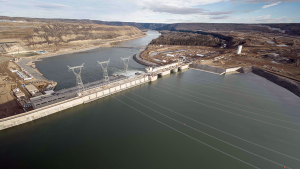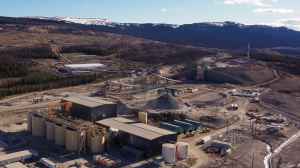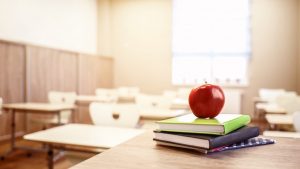The $50-million expansion at Point Hope Maritime (PHM) could start construction before the end of 2018, says general manager Riccardo Regosa.
The investment in expanding the shipyard’s facilities, which are part of the Ralmax Group of Companies, will allow it to accommodate larger vessels within its existing footprint, with the City of Victoria recently giving the nod of approval for the expansion. PHM is currently working with environmental consultants to provide the information needed for approvals from Fisheries and Oceans Canada and Transport Canada.
A graving dock, also known as a dry dock, is a basin where vessels can be floated in and then rested on braces once the area is drained enabling crews to carry out maintenance or repairs on the vessel.
“We have for many years been asked if we can service larger vessels and the construction of the graving dock will make that possible,” said Regosa.
The graving dock redesign will allow for a mid-gate which can accommodate one vessel up to a 170-metre length with a six-metre draft, or two smaller vessels.
PHM is located on Victoria’s Upper Harbour between the Bay Street and Johnson Street bridges. It sits on the site of B.C.’s first shipyard started in 1873. While shipyard owners have come and gone, the site has been active in shipbuilding for 145 years.
The graving yard expansion includes replacing the existing pile dock facility, which is approximately 50 years old, and redefining the new foreshore with concrete caissons. Dredging will be required to create the deeper basin for the handling the larger vessels. At the same time, the work will provide the opportunity to remediate the foreshore as it has been used by heavy industry over hundreds of years.
The expansion will add approximately 850 linear feet to the graving dock area.
The dry dock, located behind the newly-created foreshore, will be constructed of concrete with a steel gate. The revamped foreshore will allow for 180 metres of moorage alongside to accommodate vessels awaiting or returning from repairs or maintenance.
The graving dock will also add 200 more skilled workers, doubling the workforce in the shipyard, and will provide the potential to participate in new vessel construction.
Regosa said a portion of the work will be done by Ralmax Group companies, which includes Ralmax Contracting, but the rest will rely upon contractors and subcontractors.
The other Ralmax companies (besides the contracting and shipyard) within the group include Ellice Recycle Ltd., United Engineering Ltd., Chew Excavating Ltd., Trio Ready-Mix Ltd. and Trio Landscape Supply Ltd.
The Ralmax Group also has 49 per cent partnership in Salish Sea Industrial Services Ltd., with the Songhee and Esquimalt First Nations. Salish Sea specializes in marine construction and also provides on-the-job training. Ralmax uses one union across all its companies which allows for flexibility during construction, said Regosa.
In addition, Regosa said, the company invests locally on job training programs with Camosun College and has on staff an employment coach who is actively recruiting Indigenous community members who want to learn construction and shipbuilding skills.
The overall site design for the project is still being worked on, said Regosa.
PHM will be consolidating offices with other Ralmax offices onsite and will move into another building. The shipyard’s old office is being dismantled.
In addition, the Ralmax Group is modifying a building that also houses a small branch office of United Engineering, although the main office for the engineering firm is located at Victoria International Airport.
No contracts for project or construction management have been tendered yet.
The investment has drawn praise from the City of Victoria.
“Since acquiring the shipyard in 2003, Point Hope Maritime has consistently invested in modernization upgrades that not only allow for business growth, but that also ensure the responsible protection and enjoyment of our harbour environment,” said Victoria Mayor Lisa Helps.
“The addition of the graving dock will benefit our entire marine sector and create hundreds of important new jobs with wages that sustain families.”
From 2003 to 2006, Ralmax shut down the site to spend $20 million for a site-wide water catchment treatment system and a new marine railway system with three spurs that increased its capacity by 300 per cent. Since then it has been operating at full capacity and turning business away, said Regosa.
Rory Kulmala, CEO of the Vancouver Island Construction Association, said: “Any project with a value north of $10 million is good for the community.”
Kulmala, who spent a decade with BC Ferries, said the expansion is a positive move towards revitalizing the B.C. shipyard and building industry.
“We are an Island-based economy and it makes sense to invest in a shipyard,” he said, adding organizations, such as BC Ferries, spend millions on terminal and fleet repairs.
A portion of that BC Ferries budget is headed to PHM as in mid-2017 the ferry corporation inked a five-year, $40-million service contract with the shipyard to handle the dry docking and repairs on eight smaller ferries in the BC Ferries total fleet of 35 vessels.
Kulmala said there is good potential to build more vessels on the West Coast and during his stint in the navy he sailed on vessels built in B.C.
“We don’t see ourselves as a maritime province,” he said. “But we have one of the longest salt water shorelines in the world.”
While there is a growing skills shortage in construction, Kulmala said the construction industry on Vancouver Island is still able to fill the demand.
“We seem to be punching above our weight,” he said.











Hopefully they can put new tin on the existing buildings because the old stuff looks very old.